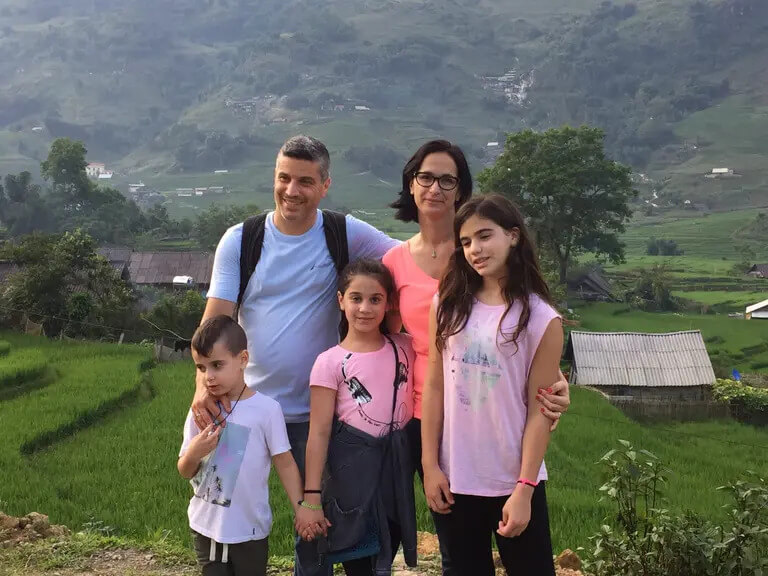
Mountain sickness – the guide to all types of climbing trips – from family trips to professional ones
Trips, and especially those in exotic places, carry a lot of excitement but these adventures can also pose people in danger. This danger and adventurism can be quantified and prepared for.
Our website has a general chapter about traveling abroad with children, and slowly we have been getting into trips that are more suitable for older people and less for families with children.
And this chapter will aim to give you the answers to all the questions you may have about mountain sickness.
The shorthand story is known to everyone – mountain sickness is the body’s natural response to the reduction in the air’s oxygen pressure at an altitude that is usually greater than 2500-3000 meters. As you go up in altitude, the air pressure decreases and the amount of oxygen you take in with every breath decreases. The body needs to adjust to this rapidly and sometimes unpleasant symptoms develop.
How can you avoid this? How do you recognize it? And how can it be treated?
You will find all your answers in this chapter.
We will start off with the basics, which is not something other resources typically do, but I’m sure that those of you who will read this part will enjoy reading, gain wisdom, and learn how to make better decisions.
Mountain sickness? Is that the right name for it?
The truth is that mountain sickness is the name given to a spectrum of medical conditions that overlap but have similar neurological and respiratory presentations as you will see below.
What are the different types of mountain sicknesses?
Keep in mind that the three types can be treated as different illnesses or as a continuous spectrum of similar medical conditions.
1. Acute Mountain Sickness – AMS
This is the most common type and the mildest type. It presents between hours to one day from when one reaches the high altitude. Usually the symptoms include headache, weakness, dizziness, and sometimes nausea and vomiting. As you will see below, this is a lot more common that what you would think and occurs also during family trips to areas that are not as exotic as you would expect.
2. High-altitude cerebral edema (HACE)
This is very severe and rare. Symptoms that may appear include neurological symptoms such as confusion, postural imbalance, altered consciousness and even loss of consciousness. It is very dangerous, life threatening and required immediate medical attention.
3. High-altitude pulmonary edema (HAPE)
This is also very severe and required immediate treatment. Symptoms including difficulties breathing (also at rest), coughing, extreme fatigue and the feeling of inability to breathe.
At what altitude can mountain sickness develop?
It can develop anywhere above an altitude of 1500m. These are altitudes in which people with certain chronic conditions may start to feel unwell.
What altitude is it more common at? Usually higher than 2500-3000m.
What are the risk factors for development of mountain sickness?
A combination of several risk factors, including:
The climber’s baseline health – there are certain chronic conditions that may pose people (children and adults) at higher risk of developing mountain sickness and these include cardiac and pulmonary diseases mostly.
The altitude itself – obviously. The higher the rate of ascent, the higher the risk of disease.
Previous exposure to high altitudes
Previous response to similar altitudes – those who had previously experiencing mountain sickness, are at especially higher risk of developing mountain sickness given a similar scenario
The mode of ascent – flying and reaching the high altitude compared to slowly climbing up.
Where you spend the night – those who also sleep at high altitudes will have a higher risk of developing mountain sickness.
Genes
Lack of accommodation
Accommodation?
Accommodation means staying at high altitude for a while before ascending to a higher altitude, to allow the body to adjust to the physiological changes that it is going through.
Accommodation is individual and can vary among individuals, but at the end of the day, we expect the heart rate to come down normal range (sea level) within a few days and this indicates successful accommodation.
Can mountain sickness occur after a flight?
Of course.
If you fly 3500m above sea level, there is a good chance that a few hours after your land you will develop a degree of mountain sickness. The chance is higher than if you were to as end to this altitude by foot over the span of a few days.
What are the common signs of symptoms for mountain sickness?
There’s quite a lot.
# Headaches – this is the most common one. many of the medical ladders that have been put together to try and detect mountain sickness consider headaches to be the primary symptom
# Dizziness
# Fatigue or lethargy
# Lack of appetite, nausea and vomiting
# Sleep disorders
# In younger children – irritability, a decrease in the desire to play, loss of appetite, sleep disorders. And of course, a child at the appropriate age will also complain of the characteristic headaches
# Severe neurological signs – ataxia (imbalance), confusion and altered consciousness, seizures and neurological deficits.
# Severe respiratory symptoms – shortness of breath, including at rest, cough, fatigue, decreased activity, rapid heart rate and cyanosis.
But there are a lot of reasons to get a headache when on a trip
That’s right. The physical effort, dehydration, sun, excitement and what not.
How can one avoid mountain sickness?
In one sentence – you give it some thought and get ready. How?
# Gradual ascent (not more than 300-500m per day when over an altitude of 3000m). Including avoiding taking flights to high altitude from low altitude.
# Sleeping at a lower altitude than the one you reached that same day
# Drinking lots of water
# Avoiding excessive physical effort at a high altitude
# In certain situations, taking medications such as acetazolamide, after consulting with a physician
How is mountain sickness treated?
Again, keep in mind that this is not a single disease but a spectrum of diseases.
# Obviously the definite treatment for mountain sickness, especially one that manifests with severe symptoms, is descending immediately (preferably at least 300-500m)
# Obviously, to stop ascending and to avoid sleeping at a high altitude.
Additional things:
# Complete rest when you reach the altitude at which the symptoms appeared – a type of adjustment for 1-4 days.
# Drinking sufficient fluids
# Analgesics (such as paracetamol or ibuprofen)
# Acetazolamide (adjusted dosage) – see below
# Treatment with oxygen
# Other medications such as steroids
# Do not forget to seek medical attention in severe situations or if you do not see an improvement within 24-48 hours.
What is Acetazolamide?
This an important medication that acts as a diuretic (inhibits a certain enzyme in the kidneys) and eventually increases the concentration of oxygen in the blood. As previously mentioned, it can be used both for prevention and treatment of mountain sickness. The maximal dose is 250mg twice daily (in severe cases can be up to 4 times daily) and the preventive dosage is 125 mg twice daily.
When used for prevention it is typically administered one day prior to the start of ascent and for a duration of about 2 days after reaching the target altitude.
Find out more about acetazolamide and its side effects.
What about natural medications to prevent mountain sickness?
Nonsense, no matter what they tell you.
Dr Efi, we thought this was a website intended for children! How is mountain sickness related to kids?
Kids too can develop mountain sickness, and sometimes it may be difficult to detect the symptoms early because kids may struggle to express their physical feelings. It is therefore very important to ensure:
# Gradual ascent
# Observing the child’s mood and behaviour
# Ensuring good nutrition and good hydration
# Medical consult before and after ascent – the pulmonary presentation may sometimes present in children after they have returned to the lower altitude
# Adjusting the dose of medication according to age and weight
What should be done in the moment of truth, when mountain sickness develops?
This applies to both adults and children:
Stop climbing immediately – do not continue ascent
Complete rest, drink water, take a simple medication for the headache
Wait a few hours, if it is mild, you may see improvement in symptoms within a few hours of rest
If the symptoms do not improve or worsen (confusion, shortness of breath at rest, postural imbalance) – begin descent immediately
Seek medical attention – especially if the patient is a child or the symptoms last longer than 24 hours
Prior to your next ascent, consult with a physician once again
In summary, mountain sickness may sound scary, but it is important to point out that in most cases it is mild and transient, especially if one ascends gradually, drinks plenty of water and listens to their body and rests when needed.
With a little bit of background knowledge and a lot of attention, even families with young children can enjoy the beautiful views from high mountains – safely and happily.
If you notice any symptoms, do not stress – simply follow the above instructions and do not hesitate to descend or consult with a doctor.
Mountains are fun, just allow your body time to adjust.
For comments and questions, please register
